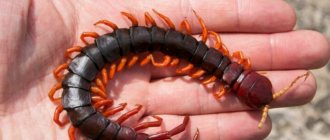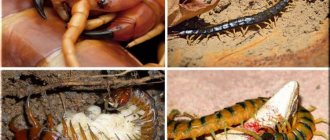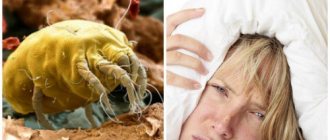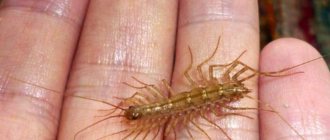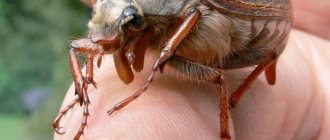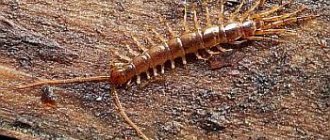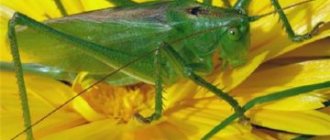Description
Scolopendra is a centipede that belongs to the class of arthropods. In most cases, these predators (since they feed on other insects) are poisonous and pose a danger to people. Meeting a centipede in the house is not the most pleasant event, and you should get rid of it as soon as possible.
Where do scolopendras come from in the house? Millipedes love moisture and are therefore often found in basements, bathrooms and kitchens. They come to the apartment not only for comfortable living conditions, but also in search of food.
What to do if a centipede is spotted in the house? What to do if she bites? What measures should be taken, and what means of combating scolopendra are more effective: folk or professional? The answers to all these questions can be found in the article.
Video - ringed scolopendra, poison
If the victim leaves the battlefield, then the centipede slowly follows the trail of the doomed prey, keeping a decent distance from it, but not letting it out of sight (or rather, smell). A hungry scolopendra can attack an insect by raising its head, like a snake, and making lightning-fast attacks, but this happens very rarely. After finishing the meal, unclaimed insects must be removed so that they do not injure the scolopendra that has decided to molt.
“Centipedes” quickly get used to taking food from tweezers, and in the absence of insects they can be content with pieces of minced beef and cottage cheese. But you shouldn’t keep him on such a diet for a long time: this is only a temporary measure.
Large scolopendras may not emerge from the nest for two months and not react to feeding insects released towards it. There is no need to worry, such rest does not harm the health of the arthropod.
What is the difference between a scolopendra and a flycatcher?
There is an opinion that the centipede is the same as the flycatcher. It is worth noting that in appearance they have some similarities, but these are different insects.
The main differences between the centipede and the flycatcher are as follows:
- Appearance. The flycatcher grows up to 60 millimeters, while the centipede can reach 20 centimeters or more in length. The antennae of the flycatcher are long and thin, consisting of 500 segments, while those of the centipede can vary in size and color depending on the species. The scolopendra's body is denser, covered with a shell, which allows it to move freely on rocky surfaces.
- Lifestyle. The flycatcher remains active not only at night, but also during the day. Scolopendra hunts only in the dark.
- Bite. The flycatcher very rarely bites humans. It is difficult for her to bite through the skin; it can only damage the top layer. The flycatcher itself will not attack people, but if you hold it in your hands for a long time, it will, of course, attack. Despite the fact that the flycatcher has poison, it is unable to harm humans. © https://ydoo.info/qa/skolopendra-v-dome.htmlThe sting of a scolopendra is not only very painful, but also dangerous, as it can cause an allergic reaction, which is accompanied by fever and general weakness.
Flycatchers are not dangerous to people or pets. They hunt flies and mosquitoes. But the appearance of insects is unpleasant, so they prefer to destroy them.
For some, the appearance of scolopendra in the house is a good sign: wait for good news. Moreover, the larger the centipede, the better the news. Therefore, according to popular belief, it is undesirable to kill the scolopendra; it should be carefully swept over the threshold with a broom. It should be noted that this is extremely difficult to do, since the insect develops great speed, which makes it almost impossible to catch it.
Fighting methods
House scolopendra, despite its name, spends most of its life in the wild. It usually settles under trees or under fallen leaves. It overwinters in secluded places, and with the arrival of stable warmth, it gets out of the shelter and goes in search of food.
In autumn, when the temperature drops again, flycatchers flock to warm residential buildings and, if there is sufficient humidity and plentiful food, happily remain there. And the owners of apartments and houses immediately face the question of how to get rid of the domestic centipede.
first of all, it is necessary to remove dampness and reduce humidity, special attention should be paid to the bathroom, kitchen and bathroom, in addition, it is recommended to ventilate the pantry; Sticky traps can help catch flycatchers - they are placed in the above rooms and changed as they are filled; if you find only one centipede, then simply throw it out of the house; Aerosol insecticides cope quite well with centipedes, and you can use any preparation against crawling insects: “Raptor”, “Combat”, “Raid”, etc. You can also use poisonous gels - among the most effective are Globol, Fas and "Storm"; pay special attention to the destruction of domestic insects - if the centipede does not have anything to eat, it will soon leave your house on its own; close all possible entry points for centipedes - inspect the foundation, floor, walls, window frames and doorways and, if cracks are found, repair them immediately. In short, in order to get rid of the domestic scolopendra, you need to establish ideal order in your home and try to constantly maintain it
Avoid stagnation of water and high humidity, carry out timely control of small pests and clean up the yard
In a word, in order to get rid of domestic scolopendra, you need to establish ideal order in your home and try to constantly maintain it. Avoid stagnation of water and high humidity, carry out timely control of small pests and clean up the yard.
Despite the fact that scolopendras have recently gained popularity as pets, for most people these creatures are extremely unpleasant.
The sight of a scolopendra is truly frightening. This is not an ordinary centipede, but a creature with long legs and a segmented chitinous skeleton.
Centipedes that live in houses and apartments are more correctly called common flycatchers. In a sense, flycatchers are even useful in everyday life - they catch flies, cockroaches, fleas, moths, and spiders.
Such centipedes are not too dangerous for humans, they can rather frighten. An angry flycatcher moves very quickly, and if it comes into contact with a person’s skin, it can sting, but this sting is no more dangerous than a bee sting.
In the southern regions there are also ringed scolopendras, which can reach 10-15 cm in length. These are much more dangerous guests that can cause unpleasant burns.
If you are not happy with such guests, then first of all you need to remove all the cracks in the walls, reduce the humidity, which attracts these creatures, try to better ventilate the room and better illuminate it. Centipedes themselves can only be caught mechanically. The problem is that their chitinous layer is very strong, so it is not easy to kill a centipede. It is better to catch it in a jar and release it as far from home as possible.
Types of scolopendra
Now there are about 90 species of scolopendra. All of them feed on invertebrate insects, and large individuals can even attack lizards, mice and toads.
Small
The little centipede, or, as it is often called, the house flycatcher, is that same flycatcher. The following varieties are distinguished:
- arachnid (black) scolopendra.
- ordinary.
They differ mainly in color: the former are darker, and the latter are often brown or light yellow.
Crimean
Crimean, or ringed, scolopendra grows up to 15 centimeters in length. Her legs are short but strong. The body is flat, covered with a chitinous shell, which allows it to easily penetrate into homes. The Crimean centipede is aggressive and can attack humans.
This insect primarily lives in the Crimea (which is where it got its name). It loves damp and dark places, so it is most often found under stones, in wood and in foliage. The basement is also the centipede's favorite habitat. If you don’t get rid of the scolopendra there, it will move into your house or apartment.
The Crimean centipede, when irritated, releases poison not from the bite, but from the entire body. If such a centipede crawls across a person’s skin, discomfort and burning will occur.
Ringed
Lives in Southern Europe. The maximum size is 15 centimeters in length. Body color varies from brown to orange, with females always being darker. The body structure of the ringed scolopendra is similar to the Crimean one. It can also very often be found in houses or apartments.
Gigantic
The giant scolopendra is one of the most striking representatives of its genus. Lives in the southern and western parts of America. The giant centipede is capable of attacking lizards, toads, mice and even birds.
Types of predators
Typical representatives of this order of centipedes are the ringed scolopendra, Californian scolopendra and Lucas scolopendra. But there are other varieties of these predators, which are their closest relatives.
- Californian. It is green in color and is classified as a giant, as its body size reaches 20 centimeters. Lives in arid regions of Mexico and the USA. Whether scolopendra is dangerous for humans in normal conditions can be seen by observing the predator in the wild. In a calm environment, the centipede does not pose any threat, but in case of danger, running its numerous legs over a person’s skin causes inflammation at the site of contact. For all time, only one death of a seven-year-old child in the Philippines from the bite of this poisonous centipede has been recorded.
- Ringed centipede. Found in Mediterranean countries, Southern Europe, North Africa, and the southern region of Russia. It is widespread in Crimea. The body length is from 14 to 17 centimeters. Scolopendra is painted in a beautiful golden yellow color, but is also poisonous, like its relatives.
- Vietnamese. This representative is distinguished by the secretion of a luminous liquid that smells of phosphorus, which severely burns the skin and causes inflammation. The bite of the Scolopendra subspinipes insect produces a wound up to 1.5 cm in diameter and 5 mm in depth. The toxin is similar in action to viper venom. The wound bleeds for a long time, since a special substance is injected along with the poison that prevents blood clotting. There is an increase in temperature to 39-40 degrees and an increase in the bitten limb several times. The injured person must be immediately given an antiallergic drug and taken to the nearest hospital.
- African scolopendra. She can make noise with her hind legs in the form of chirping and crackling noises to scare away enemies. The individuals themselves do not react to this sound in any way.
- Blind, poisonous centipedes, Cryptops, live in the upper layers of the soil. They, like moles, practically never appear on the surface. These small yellow-brown scolopendras, 3–4 cm long, can be found in steppe regions and in garden plots even in Moscow latitudes. They do not pose a danger, since the weak jaw apparatus cannot bite through human skin. In the tropics there are various species of these insects, which are colored in different colors, ranging from green to purple hues.
- Drupes (Lithobiomorpha) are small relatives of centipedes. They can accidentally get into the stomach with fruit or crawl into a sleeping person’s nose or ear, but this happens very rarely. Mainly found in cities near damp foundations.
- The Scutigera coleoptrata has 15 pairs of long legs and long antennae. Scolopendra is a nocturnal insect, but this species can be seen during the day on the wall of a house. Preys on flies and other small insects. It tolerates dry air best of all species, although in the hottest daytime it tries to hide in shelter. Scolopendra of this species is able to be active at lower temperatures, which provides it with advantages in hunting over other insects. Today it is rarely seen in Crimea. The black scolopendra also belongs to the scutiger class.
What to do if you are bitten?
The centipede rarely attacks itself, but if this happens, you need to know what to do if it bites.
- First, you need to thoroughly wash the bite site with soap (preferably household soap), and then treat it with alcohol.
- Apply a sterile bandage.
- Rest more and drink fluids so that the poison leaves the body faster.
- Contact your doctor.
Under no circumstances should you drink alcohol. It speeds up the metabolism, which causes the poison to spread faster throughout the body, which leads to a worsening of the condition.
Symptoms
The main symptoms after a scolopendra bite are as follows:
- swelling and redness at the site of the bite;
- pain (can be compared to a hornet sting);
- increased temperature (sometimes up to 39 degrees);
- itching;
- general intoxication of the body.
Important! Symptoms may persist for 1-2 days, so it is important to monitor the condition and consult a doctor if necessary.
In most cases, scolopendra venom is not fatal. This is only possible if a person is allergic to some component of the poison or has cardiovascular diseases. However, symptoms can usually be relieved if you go to the hospital in a timely manner.
It is worth noting that domestic scolopendras (flycatchers) do not cause such symptoms. If they sting, only slight redness and a burning sensation may appear at the site of the lesion.
Female centipedes are more poisonous than males. Moreover, they are more active and aggressive, so they attack more often.
How to protect yourself from scolopendra?
Most often, scolopendras attack people in nature, climbing into tents and getting into clothes. Therefore, it is very important to know how to protect yourself from scolopendra in the fresh air.
- Close your tent carefully and check for insects before climbing into it.
- Carefully inspect clothing and shoes.
- Do not go outdoors in the dark.
- Carefully lift branches and stones.
If a scolopendra bites a child or a pregnant woman, you should definitely consult a doctor!
What should you not do after being bitten?
There are some things you should not do after being bitten by a scolopendra. The most important thing is that you should not cut the bite site in the hope of getting rid of the poison. Also, do not apply a tourniquet, as this will lead to stagnation of blood and even greater problems. Do not try to catch up and kill the scolopendra.
Reproduction and nutrition
The centipede is a predator and a good hunter. Therefore, it is clear what scolopendra eats. Like any predator, it eats small worms, beetle larvae, flies, and insects. Large individuals are capable of attacking small lizards, frogs, birds, mice, snakes and even bats.
Centipede breeding occurs in the warm season. This period lasts from late spring to early summer. The male covers the entrance to his home with a web and deposits a sac of sperm called a spermatophore on it. The female then crawls over this sac, capturing it to fertilize the eggs. In Crimea there are species that reproduce parthenogenetically without males.The female exhibits maternal instinct by guarding the laid eggs for several weeks by wrapping her legs around them. At this time, it releases substances that protect against the development of mold. After the appearance of young offspring, the female leaves. Scolopendras are born white and soft, then they molt several times, darken and begin an independent life. Centipedes live 1-2 years, large relatives can live up to 7 years, usually in captivity.
In Russia there are centipedes that do not pose such a threat as tropical representatives. The domestic scolopendra, which lives in human homes, is practically harmless. It even brings benefits by eating flies, moths, cockroaches, bedbugs, and ants. It reaches a length of 2-6 cm. The scolopendra bites only for self-defense. Its jaws are very weak and cannot bite through human skin. But if this does happen, then the predator’s bite is as painful as that of a bee.
Why do they appear in the house?
There are two reasons why scolopendras may appear in the house:
- optimal living conditions (when it is warm and dry outside, and the houses are humid and damp);
- availability of food.
Centipedes often appear in those houses and apartments where there are basements, because it is always dark and high humidity. From there, in search of food, insects can climb into houses through cracks, and into apartments through pipes.
If a scolopendra is noticed in the house, then you should carefully inspect the home, since, most likely, the centipede came here in search of food. She usually hunts cockroaches, spiders and bedbugs.
Chemicals
How to get rid of scolopendra in a private house or apartment? Chemical agents are considered the most effective in the fight against insects. Most often, broad-spectrum drugs are used, which are designed to destroy various harmful insects. This should include:
- "Medilis Cyper".
- "Dichlorvos".
- "Raid".
- Starex.
- Henkel Kombat.
Before getting rid of scolopendra using insecticidal preparations, you need to put on personal protective equipment: rubber gloves, a respirator, and the most closed clothing possible.
How to get rid of it?
Of course, if you notice one centipede in the house, you shouldn’t panic, but if there are more than 2-3 of them, then it’s better to get rid of them as soon as possible.
How to deal with centipedes in the house? You won’t be able to get rid of centipede with a slipper by simply slamming it down, since the body of this insect is flat and covered with a dense shell. The main methods of combating centipedes are divided into folk and professional. Moreover, it is necessary to poison not only the centipede, but also the food for which it came, that is, Prussians, bedbugs, ants and other insects.
Folk remedies
Folk remedies are not always effective, but they are safer, especially if there are four-legged pets in the house. However, it is worth noting that the chemicals now produced are of quite high quality and can also be used at home without harm to people and animals.
Boric acid
Treating floors and baseboards with boric acid is the simplest and most effective way to combat scolopendra. In this case, there is no need to mix the substance with anything; it is enough to simply apply it in those places where the centipede is most likely to live.
Adhesive tapes
Double-sided tape can be used as adhesive tape. It should be pasted in those places where scolopendra lives, and several flies should be placed on the sticky surface as bait. The centipede will come for food and stick itself.
This method of fighting insects is quite humane, but if the individual is too large, the adhesive tape will not hold it, and the centipede will simply run away.
Fighting against scolopendra using folk remedies is not always effective, since it does not see well and often does not notice baits and traps made for it. Therefore, it is better to use special chemicals.
Professional chemistry
It is with the help of professional chemistry that you can achieve quick results in the fight against scolopendra. There are several chemical options that can be used against centipedes.
Aerosols
In most cases, aerosols work well against scolopendras. Ideally, it is necessary to spray the centipede itself with the product, but sometimes it is enough to treat the places where it was noticed. Crawling along the treated surface, it catches particles of chemicals with its paws, which gradually poison it.
Ordinary dichlorvos fights scolopendra quite well. However, this product is toxic, so they need to treat the rooms wearing protective masks, and some time after the procedure, ventilate the rooms well.
Liquid insecticides
Typically, liquid insecticides are sold in large bottles where the concentration of chemicals is very high, so these products must be diluted before use. It is very important to read the instructions, as the manufacturer may have recommendations for use.
Liquid insecticides should be applied to surfaces where scolopendra has been spotted. As a rule, these are baseboards, corners, crevices and nooks in the apartment.
Disinsection service
Unfortunately, only a disinfestation service can cope with a large infestation of scolopendras, whose employees, when starting treatment, take into account the following factors:
- affected area;
- the number of centipedes, as well as other dangerous insects that may be in the house;
- processing tools that may have been used before.
The last point is extremely important. If earlier attempts were made to combat scolopendras, which did not produce results, this may indicate that the insects have developed immunity to chemicals, and exterminators now need to select stronger drugs.
The pest control service can use the following methods to combat centipedes:
- Cold fog. It involves irrigating a room using a special machine. Small (up to 50 microns) particles of chemicals create a cloud that settles for several hours, making the millipede more likely to be exposed to the insecticide and become infected.
- Hot fog. This is a dry method of irrigating a room using a special machine that heats chemicals and then sprays them under high pressure. The insecticide particles in this case are even smaller than with cold fog - about 0.5 microns.
By treating the room with the second method, you can get rid of not only insects, but also bacteria.
Preventive actions
In order to never wonder about how to get rid of scolopendra in the house, it is necessary to take preventive measures.
- Fighting moisture. The fact is that centipedes are very afraid of lack of humidity. Drying the room is considered the most global and simplest method, since where it is dry, light and clean, insects will not grow. That is why it is necessary to regularly ventilate your apartment. You should also eliminate all plumbing breakdowns and stagnant moisture under the bathtub or sink.
- Insulation. Another important rule is to seal small gaps, cracks, cracks, and voids through which centipedes can enter the house.
- Window protection. It is best to protect windows with mosquito nets. After all, they are most often the main route for insects to enter the house.
- Fight against other domestic insects, which include ants, fleas, cockroaches, as they act as food for scolopendra.
Cleaning the area around the house from various deposits of debris, as well as from fallen leaves, which can serve as a shelter for centipedes.
